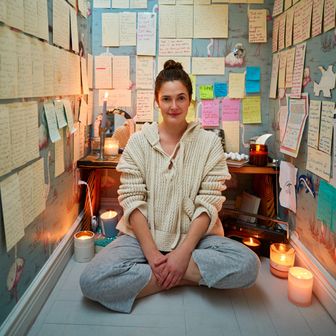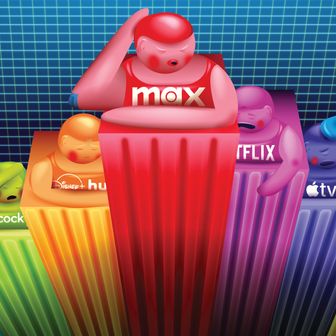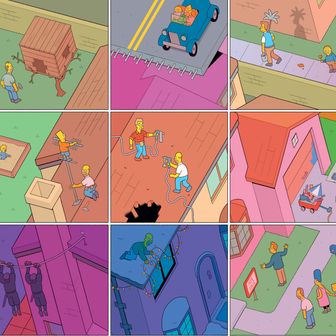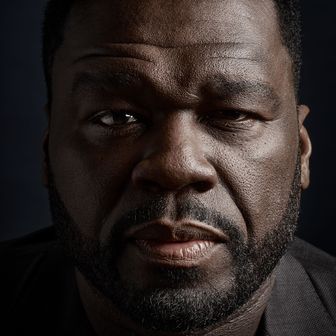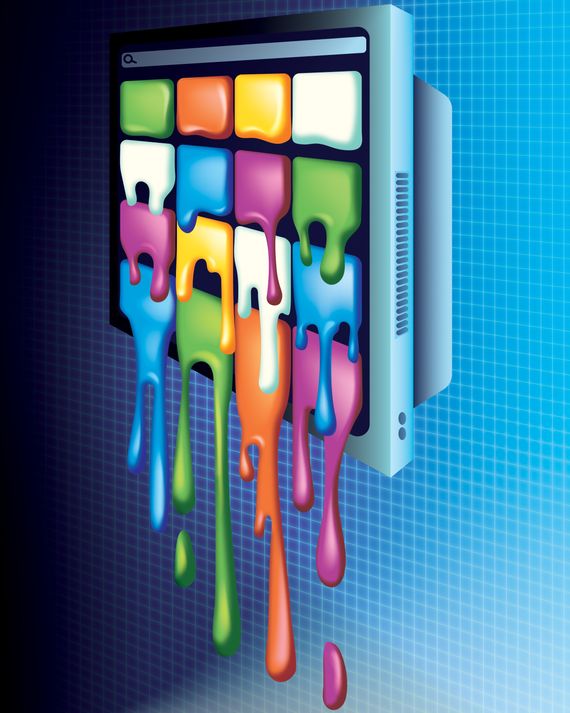
This article was featured in One Great Story, New York’s reading recommendation newsletter. Sign up here to get it nightly.
If you call a slew of Hollywood’s most powerful showrunners, studio chiefs, agents, and operators and ask them to describe the state of the television business, they will say things like:
“This is the single worst time to be making anything in the history of the medium. It’s just as dark as it’s ever been.”
“It’s such a fucking disaster, isn’t it?”
“It’s like the entire system has snapped.”
“These companies took what was an extraordinarily successful economic model and they destroyed it in favor of a model that may or may not work — but almost certainly won’t work as well as the old model.”
“Everything became big tech — the Amazon model of ‘We don’t actually have to make money; we just have to show shareholder growth.’ Everyone said, ‘Great. That seems like the thing to do.’ Which essentially was like, ‘Let’s all commit ritual suicide. Let’s take one of the truly successful money-printing inventions in the history of the modern world — which was the carriage system with cable television — and let’s just end it and reinvent ourselves as tech companies, where we pour billions down the drain in pursuit of a return that is completely speculative, still, this many years into it.’”
“The reason nobody really wants to open the books on this is because if Wall Street got a look, they’d have a collective stroke.”
“Where’s my Alias? Where’s my West Wing? Where’s my 24? Where’s my Ally McBeal, Once and Again, and Brothers & Sisters? I have a friend who works at Netflix, and for years I’ve been asking, ‘When are all of you streamers going to get your prestige heads out of your asses?’”
“We’ve invited all these fancy artists into the medium, and they look at it like art, not a job.”
“People are getting fucked. By the way, there’s a real social-progressive way to look at that, which nobody talks about, which is that the people who’ve gotten pushed out of the Hollywood economy generally are older white men. Because now they’re competing with younger people and women and people of color that they never had to compete with before. And it hurts.”
“The industry went a little crazy, and there’s going to be some pain in it righting itself, but I actually think it’s going to get to what hopefully will be more normal and livable, the place where we should have been the whole time.”
“I think we may be in the world’s biggest Ponzi scheme.”
It’s been a little more than a year since the Great Netflix Freak-out, when the streaming pioneer’s first-ever loss of subscribers and ensuing stock drop sparked overdramatic proclamations that TV as we’d come to know it was finished. In that time, it’s become clear that the business model dominating modern Hollywood is deeply broken but also that it probably isn’t going anywhere — at least not yet.
Across the town, there’s despair and creative destruction and all sorts of countervailing indicators. Certain shows that were enthusiastically green-lit two years ago probably wouldn’t be made now. Yet there are still streamers burning mountains of cash to entertain audiences that already have too much to watch. Netflix has tightened the screws and recovered somewhat, but the inarguable consensus is that there is still a great deal of pain to come as the industry cuts back, consolidates, and fumbles toward a more functional economic framework. The high-stakes Writers Guild of America strike has focused attention on Hollywood’s labor unrest, but the really systemic issue is streaming’s busted math. There may be no problem more foundational than the way the system monetizes its biggest hits: It doesn’t.
In This Issue
Drew Barrymore Lights Up Daytime
Just ask Shawn Ryan. In April, the veteran TV producer’s latest show, the spy thriller The Night Agent, became the fifth-most-watched English-language original series in Netflix’s history, generating 627 million viewing hours in its first four weeks. As it climbed to the heights of such platform-defining smashes as Stranger Things and Bridgerton, Ryan wondered how The Night Agent’s success might be reflected in his compensation.
“I had done the calculations. Half a billion hours is the equivalent of over 61 million people watching all ten episodes in 18 days. Those shows that air after the Super Bowl — it’s like having five or ten of them. So I asked my lawyer, ‘What does that mean?’” recalls Ryan. As it turns out, not much. “In my case, it means that I got paid what I got paid. I’ll get a little bonus when season two gets picked up and a nominal royalty fee for each additional episode that gets made. But if you think I’m going out and buying a private jet, you’re way, way off.”
Ryan says he’ll probably make less money from The Night Agent than he did from The Shield, the cop drama he created in 2002, even though the latter ran on the then-nascent cable channel FX and never delivered Super Bowl numbers. “The promise was that if you made the company billions, you were going to get a lot of millions,” he says. “That promise has gone away.”
Nobody is crying for Ryan, of course, and he wouldn’t want them to. (“I’m not complaining!” he says. “I’m not unaware of my position relative to most people financially.”) But he has a point. Once, in a more rational time, there was a direct relationship between the number of people who watched a show and the number of jets its creator could buy. More viewers meant higher ad rates, and the biggest hits could be sold to syndication and international markets. The people behind those hits got a cut, which is why the duo who invented Friends probably haven’t flown commercial since the 1990s. Streaming shows, in contrast, have fewer ads (or none at all) and are typically confined to their original platforms forever. For the people who make TV, the connection between ratings and reward has been severed.
So who is getting rich off hits like The Night Agent? Not streaming services, no matter how many global viewing hours they accumulate. Many streamers have spent themselves into billions of dollars of debt building their content libraries, and subscription fees haven’t grown fast enough to close the gap. If platforms like Netflix make any money at all, it is only a fraction of what entertainment companies used to make back when more than 105 million U.S. households spent an average of $75 per month on cable.
“The entire industry,” says the director Steven Soderbergh, who has been navigating structural changes in Hollywood since 1989’s Sex, Lies, and Videotape, “has moved from a world of Newtonian economics into a world of quantum economics, where two things that seem to be in opposition can be true at the same time: You can have a massive hit on your platform, but it’s not actually doing anything to increase your platform’s revenue. It’s absolutely conceivable that the streaming subscription model is the crypto of the entertainment business.”
Like cryptocurrency, which has created massive on-paper fortunes built atop 1 + 1 = 3 arithmetic, streaming TV has always seemed too good to be true but seduced a lot of smart people anyway. Over the past decade, Hollywood completely reorganized itself around the digital model, as once-mighty networks and studios turned themselves into apps and abandoned reliable income streams hoping larger ones would materialize. They tripled their output, overpaid Oscar winners to debase themselves in miniseries, and hired all of your friends to work in writers’ rooms. Viewers across every niche and taste cluster were inundated with more bespoke programming than they could ever realistically consume.
We knew it couldn’t last, and it didn’t. Amid much lip service to fiscal responsibility, streamers have signaled plans to make fewer shows — a dramatic shift considering that the number of original scripted series had exploded from 210 in 2009 to 599 in 2022. We’ll still have enough to watch, at least for a while; billions will still be spent, and Ted Sarandos alone claims to have enough Netflix content stockpiled to last through the strike and beyond.
But for a certain type of viewer — imagine someone in her 30s or 40s who has never in her adult life had to worry about where her next critically acclaimed dramedy would come from — something already feels like it’s ending. Peak TV, as one of the industry’s most powerful tastemakers wearily puts it, “was a brief but intense mania that led to too much television.”
If you’re wondering whom to blame for TV’s predicament, that’s easy: It was Netflix. “Netflix completely revolutionized a 100-year-old industry,” says Mike Schur, who created The Good Place. “Everything changed, and everything changed the way they changed it.” In 2013, Netflix released the entire first season of House of Cards on the same day, overthrowing the time-honored orderliness of weekly schedules and giving viewers a brand-new way to spend 13 consecutive hours. Then the company embarked on what was probably the biggest spending spree in entertainment history. Wall Street treated Netflix not like the next HBO but more like the next Tesla, ignoring the profit factor to focus on growth.
“We all saw Netflix’s market cap go from $20 billion to $60 billion to $100 billion,” says someone who was then an executive at a legacy TV company. “The unspoken thing was that this will all be accretive to valuation: ‘I may not be running a profitable business, but boy, is it going to add stock value!’” He eventually went to work for a streamer.
Everyone bowed to what felt like the inevitable — even the most storied brand in entertainment. In 2017, Disney CEO Bob Iger told investors that he would pull his company’s movies and shows from Netflix, ending a lucrative licensing deal, to start its own streaming service. AT&T (which then owned HBO and Warner Bros.) and Comcast (which owns NBCUniversal) did the same. They willingly sacrificed hundreds of millions in revenue at the same time they were burning billions to make shows for their new apps. Apple got in, too, and Amazon dramatically upped its commitment to Prime Video when Jeff Bezos paid a quarter of a billion dollars for the rights to adapt The Lord of the Rings. (Actually making the show would cost even more.) “The entire industry was spending money with no regard to making money,” says an executive who helped launch a Netflix rival.
It’s easy to see this now as self-immolation, but at the time, investors rewarded the spending as an investment in the future and a hedge against the trend of cord-cutting. Disney’s share price — which had been trading in the $100 range when the company announced its streaming strategy — flirted with $150 in the weeks after Disney+’s launch. COVID further juiced the value of companies whose primary market is serving shut-ins. Netflix added 36.6 million subscribers in 2020 — its biggest annual gain ever — and Disney+ did even better, finishing its first full year of operations with 86.8 million customers. Iger retired on the last day of 2021. All that was missing was a MISSION: ACCOMPLISHED banner.
The first sign of trouble came the very next month with a ten-word aside in a Netflix shareholder letter: “This added competition may be affecting our marginal growth some.” Investors began to bail. In April 2022, when the company announced that it had lost subscribers — the first decline since it had started making its own content — more than $50 billion evaporated in a single day. A stock that had been approaching $700 would soon fall below $200. Netflix began to look more like one of the fusty incumbents it had attempted to vanquish. It changed policies on commercials (good) and password sharing (bad) and eliminated hundreds of jobs.
For the company’s rivals, Netflix’s woes begot a mix of Schadenfreude and relief: Maybe sanity had prevailed. But what at first looked like a Netflix correction was in fact a streaming correction. Investors started punishing Disney, Warner Bros. Discovery, and other Netflix wannabes. “Wall Street woke up and said, ‘Actually, profitability is the only metric,’” says a senior executive at a major streamer. “The idea that you could have the optics of success, where you could add 5 million subscribers and you gained 10 percent in value? It was over.” Iger unretired to retake the CEO job at Disney.
Layoffs and budget cuts spread across Hollywood. After years of green-lighting shows with impunity, platforms invented cruel and unusual ways to cancel them. HBO Max, Disney+, Paramount+, and Hulu purged entire series from their libraries for the tax savings. Some slashed shows that had already wrapped production on full, unaired seasons; Nasim Pedrad’s Chad got pulled just hours before its premiere. Not even projects with big names were safe. In June 2022, HBO nixed J. J. Abrams’s $200 million sci-fi drama Demimonde even though it had been in development for four years and had just cast its lead actor. “The Demimonde thing shook everybody up,” says one showrunner. “If HBO can say ‘no’ to J. J. Abrams, they could say ‘no’ to anybody.”
A few weeks later, Peacock pulled the plug on Schur’s TV adaptation of Field of Dreams even though it was deep into preproduction. “They just changed their mind,” says Schur. “They didn’t want to spend the money anymore.” He notes that the project will have one lasting artifact, perhaps the ultimate monument to Peak TV’s unfulfilled potential: “We built a baseball stadium in a cornfield in Iowa that’s still sitting there as we speak.” They built it, and nobody came.
By now, the grievances of the Writers Guild are well known, especially if you live near a picket line. Its members are upset that residuals are declining, that writing staffs are shrinking, that studios may replace them with ChatGPT, and that while streamers cry poverty, they’re paying their top executives nine figures. Many of these concerns are driven by a sense that the past decade was an elaborate bait and switch.
Early on, the streaming age seemed to herald exciting possibilities for writers. As the number of series ballooned, so did the number of writing jobs, allowing more people than ever, from a wider range of backgrounds and experiences, to partake in the great American fantasy of making TV. As other creative industries disintegrated, Hollywood promised not just an escape hatch but a ladder to career advancement, as former nobodies like Severance creator Dan Erickson saw their pilot scripts pulled from slush piles and given full-season orders. Novelists and playwrights descended on L.A., and there were so many writers’ rooms to fill that a few shows even hired (God help them) journalists.
The development surge was also great for established writers — at least at first, as the new economics of streaming made it easier than ever to cash in fast. Under the old TV model, if a show was a success, its creator stood to get rich on the back-end profits. With all of linear TV’s revenue streams combined (ads plus syndication plus overseas rights), a studio might bring in $3 for every $1 in costs on a hit. The problem for writers was that most shows flopped, so there was no back end to get a piece of. Streamers offered something different. Their model, called “cost plus,” might pay $1.30 to $1.50 up front, making every show a winner — just not a very big one.
To make up for the lost back end, streamers floated performance-based incentives. Schur describes a scenario in which a platform might promise a showrunner a $100,000 bonus for season one, $250,000 for season two, $500,000 for season three, and $1.7 million for season four. “So you’re like, Holy shit. This is great!” he says. There was a catch. Many seemingly successful series began to vanish after just a couple of seasons. “What no one saw coming was they’d just kill the show before they ever had to pay that money out,” Schur says. “They kind of tricked everybody. Now if you get to 20 episodes, it’s a miracle.”
“In the disorganization and the chaos of the free-for-all,” says Julie Plec, the creator of The Vampire Diaries, “the foundational pieces of the business that made it work for everyone disappeared. We thought we were paying attention, and yet it still happened because nobody really knew anything about how any of this was working. We just all as a group sat there and watched all of the things that we had worked so hard to achieve — we watched them get taken away right from under our noses.”
Streaming bosses (and even some agents) think such complaints are overhyped. The cost-plus model offers creators pretty good, low-risk income. But on the whole, creative types aren’t looking for predictability. “Most writers are gamblers,” says someone who has created megahits in both linear and streaming TV, “and are willing to bet on their own talents. They would be much happier getting a bigger payday with big success and a more modest payday if their show didn’t work. But now everybody’s basically playing a baseball game where people can only hit singles. The ball over the fence is still only a single.”
Much has been made recently about overall deals, under which writer-producers are paid — sometimes extravagantly — for the exclusive rights to their creative labor. Netflix famously used them to poach Shonda Rhimes (in a series of pacts reportedly worth $300 million to $400 million), Ryan Murphy ($300 million), and Kenya Barris ($100 million) from its rivals. These deals are also where creators of successful shows might get some indirect recompense. (Ryan expects he’ll see a bump in his next contract, post–The Night Agent.) But most are modest, makeshift solutions designed to pay talent for the work that falls through the cracks in the streaming era.
“We talk about showrunning as if it’s a real job,” says Briarpatch creator Andy Greenwald. “But it’s not. It’s a made-up title, and it’s not a paid position. The industry used overall deals to pay showrunners correctly for the blood, sweat, and tears they pour into a show that otherwise isn’t covered. Without an overall deal, there’s a world where if I’m making an eight-episode season of a TV show, I could be paid less than a co-EP in the writers’ room because everything else that I do — from hiring the writers, to being on set and producing, to being in post for months, then doing press — is not compensated.”
Lately, aside from the case of a few superstars, the market for these long-term pacts has dampened. “Overall deals are very hard to come by right now,” says a partner at a big talent agency. While anticipation of a strike was a factor, many expect streaming’s new profit-first economics to lower the appetite for such agreements in the future, too.
Things are naturally worse for those on the industry’s lower rungs. Writers on the staffs of hit shows used to be comfortable between jobs because they earned residuals from reruns. But those checks have shrunk for streaming shows made under the cost-plus model. And now that TV seasons are typically only six-to-ten episodes long instead of the traditional 22, even writers of successful series might find themselves out of work for much of the year. Some have taken jobs in retail or driving Lyfts.
One high-level agent says that studios regard the WGA’s demands — for higher minimum pay and staffing requirements, among other things — as simply incompatible with the way TV is now made: “The Writers Guild, delusionally, is harkening back to a day when there were 25 episodes of Nash Bridges a year and repeats and residuals. Back-end payments existed because Europeans were willing to watch our garbage, and Americans were willing to watch repeats of that garbage on cable at 11 at night. The real issue is that the medium changed. Instead of getting a job as a staff writer on CSI: Miami for 46 weeks a year, now it’s a 25-week job working on Wednesday, which is a better show. That’s just progress.”
But this so-called progress may have long-term consequences. Fewer weeks of employment mean that many entry-level writers are not receiving the training they need to advance through the ranks. Staff writers are now rarely invited to sets or editing rooms to learn the skills that would someday help them create their own series.
“Television has turned into a hyperspecialized Model T assembly line where everyone does one particular tiny job,” says Schur. “You focus really hard on screwing this bolt into this piece of metal, and that’s all you do. And as a result, nobody’s learning how to make a whole car. The battle now is to figure out which patches we can put on the process so that in five or ten years, people will still know how to make TV.”
“Staffing sucks right now,” says Greenwald. “I know that there are outliers and examples that are good, but broadly, I’m hearing horror stories.” Novice workers can spend “months on a show, and the show might just get tossed. It just might never air. What kind of career are you building with that handful of ashes?”
What was Peak TV, if we’re being honest about the stuff that piled up in our queues? The last decade surely produced some of the finest television ever, spanning high-toned dramas and offbeat comedies, several of them masterpieces unlikely to have been made under any other circumstances. But there were some stinkers, too.
“There is not a linear relationship between the amount of art you make in a given year and the amount of great art that will result,” says Soderbergh, whose new series, Full Circle, arrives on Max next month. “Let’s say there are 60 shows made at one platform in a year, and six of them are great. If they make 120 the following year, that doesn’t mean they’ll get 12 great shows. The number of people that really know how to make something great is small, and those people are busy. There aren’t a lot of secret genius showrunners out there.”
Despite the genius shortage, streaming services tended to disproportionately favor an elevated form of TV-making that was frequently genius dependent: the prestige show. Maybe because there was no straightforward way to profit from their popular hits, platforms chased buzz instead, programming for critics and Emmy voters. But as competition among apps accelerated, this strategy produced so many darkly serious, cinematically embellished shows that the bad ones crowded out the good ones and not even tastemakers had time to watch them all.
“In the Watchmen writers’ room, we would play this game called Is It a Show?” says Damon Lindelof, who co-created Lost and The Leftovers. “Somebody would name a title, logline, and one of the actors, and we’d have to guess whether it was real. But the joke was it was always a show. Some were in their second or third seasons, and none of us — supposedly television professionals — had ever heard of them.”
If you feel like playing along at home, consider that for every recent coastally adored breakthrough like The Bear or Beef, there were unloved misfires such as 1899, American Gigolo, Archive 81, As We See It, Becoming Elizabeth, Dear Edward, The First Lady, Let the Right One In, The Man Who Fell to Earth, Night Sky, On the Verge, Paper Girls, Reboot, and Shantaram, which all died in their first seasons in 2022 and 2023, plus others that may have escaped the embarrassment of cancellation only by disguising themselves as limited series.
“We’re all stuck in our bubbles of awareness,” says Lindelof. “Everybody I know is watching Swarm, but then my mom and my in-laws and my young and cool brother-in-law don’t even realize it exists. So then you ask yourself, Why do I know that this show exists? TV has become very artisanal.”
It may not have helped that some streaming services thought their recommendation algorithms could replace old-fashioned marketing, which made it easy for even great shows to come and go without causing a ripple. In an attempt to make their wares stand out among the glut, some platforms simply spent more money on them with mixed results. Over time, the expensive signifiers of prestige TV — the movie stars, the set pieces, the cinematography — became so familiar and easy to appropriate that it could take viewers six or seven hours to realize the show they were watching was a fugazi. “Premium and streaming have been chasing more of a film attitude than a TV attitude, which is making shows more expensive but oftentimes not as good as they used to be,” says Ryan. “You’re seeing ideas that should’ve been movies being elongated into eight episodes, and they don’t have the narrative engines to sustain them for that long.”
“People sometimes equate cost to quality, and that’s just utter bullshit,” says a senior executive at a major streaming platform. “They think they have to spend $20 million an episode, and they don’t.”
“TV doesn’t have to be Sundance in 2008. People like their stories, and they like tuning in to see what happens next, and there’s no shame in that,” says Greenwald, who in addition to making television also co-hosts the TV podcast The Watch. “Maybe I’m the problem, calling things ‘genius’ when only 600,000 people watched them. There’s this weird stratification where shows are for either the one percent or the 99 percent. We’re either doing Barry Jenkins’s Underground Railroad at Amazon or we’re doing — what’s an example of the trashiest thing that we could think of at this moment?”
This bifurcated development system has left a hole where the more populist shows that once ruled prime time used to fit. “It’s hard to develop hit sitcoms when the people selling, pitching, buying, and programming them don’t seem to like them. They don’t seem to like what the audience likes,” says the top agent. “I mean, I’m sorry, but people seem to really like Two and a Half Men, and none of my writers want to write that. They all want to write Barry. And you know who watches Barry? Nobody.”
Streaming TV’s first decade has been compared to film’s New Hollywood of the 1970s, when studios briefly ceded control to forward-thinking young hippies, resulting in some of the greatest works in the history of the medium. But as streaming reboots itself under a mandate of financial discipline, it’s hard not to worry that its next phase might look more like the movie industry of the 1980s, when creativity was suffocated under corporate micromanaging and the rise of tentpole franchises.
As miserable as the past year has been, the next one will probably be worse. Many expect Hollywood’s labor strife to last through the summer with a chance of a double-guild strike if actors walk out when their contract expires at the end of June. (The Directors Guild of America reached its own tentative deal with the Alliance of Motion Picture and Television Producers over the weekend.) A prolonged shutdown could lead to more Demimonde-style executions with streamers canceling any projects and overall deals they consider inessential. And once a new contract is hammered out, the business will likely pick up where it left off, planning for a future with fewer shows, smaller budgets, and safer ideas.
There are already discouraging signs. Recently, TV studios have embraced preexisting intellectual property with a cravenness that would shame even the movie industry of the 2010s. Warner Bros. has announced plans to adapt the dregs of the Harry Potter books into a decade-long TV show. Lionsgate says it’s doing the same with the Twilight books. Showtime is developing three Dexter spinoffs, four Billions offshoots, and sequels to Weeds and Nurse Jackie.
Unless a pitch has major IP or a major star attached, “no one in the last year really has been like, ‘Yes, absolutely: Full season, go crazy,’ in the way that they did a few years ago,” says Schur. “Now almost everything is in this liminal space between ‘yes’ and ‘no.’”
One of the best things about the boom was that it created space for stories and voices that had usually been marginalized. But as Hollywood reverts to what it thinks are sure things, many fear that TV may lose some of that diversity. “I recently spoke to the writers of a show that would’ve featured a trans lead,” Nori Reed, a comic and writer, says in an email. “After years of development at a major studio, they were told they had to change the trans character to cis if they wanted the show to be produced. Another friend was developing a show at another major studio that featured a central trans story line. Their show was canceled. When their manager tried to shop it to other studios, they were told that nobody wants to produce trans-focused shows any longer, citing the need for ‘global appeal.’”
One prominent studio founder recalls selling a hot identity-driven title back when the industry was green-lighting everything: “We had every network giving us a series commitment. We had Apple, Amazon, Netflix, Showtime. Everybody was like, ‘What do we need to do to get this show?’ And that was off a pitch, not even a script.” But recently, when shopping a similar show, the reception was entirely different. “People are very mindful, and the barrier to get something made is very studied. It’s very sort of labored over before anyone’s willing to take the shot of actually making something,” the founder says. This time, nobody bid.
One veteran executive of color says studios and platforms have been slashing development deals even though such pacts have helped the industry make “really big strides in changing its voice” by giving so many new creators a shot. “You don’t get Quinta Brunson and Abbott Elementary unless you invest in her,” she says. “The women and people of color and the new younger voices all went away when they scaled back on development deals.”
Some of this frugality may have an ulterior motive. Insiders say the belt-tightening is partially motivated by the anticipation of more corporate shuffling. Although Warner Bros. Discovery just rebranded HBO Max as simply Max, many foresee another revamp in a few years if the company gets broken up or sold. Conventional wisdom says that Paramount+ and Peacock may struggle to survive the next round of mergers; the same goes for smaller companies such as Lionsgate and AMC Networks. There has already been some soft consolidation: Showtime will be folded into Paramount+ this summer, while Iger last month said he plans to let subscribers watch Hulu content inside the Disney+ app soon. “It’s sort of the slow avalanche you see coming. I don’t think that all of these streaming platforms can or will exist,” says an executive who works at one of those services.
Even though neither Amazon nor Apple has shown any sign of retreat, the fact that their TV shows and movies are mere side hustles to trillion-dollar tech operations means that either company could suddenly rethink its commitment to streaming. “If Amazon said tomorrow they were just gonna do sports and sell digital copies of shows but not make any more originals, my guess is their stock price might go up, and I don’t think they would lose a single Prime subscriber,” says one streaming executive, who says the same applies to Apple. “Anytime something’s not a core business, it’s up for speculation.”
Many in the industry have conjectured that the streaming ecosystem may eventually shrink to four major platforms. If that’s the case, then we’d have sacrificed cable only to replace it with a broadcast-style monopoly. A world with fewer apps could have immediate downsides for both consumers and creators. A number of streamers have raised their prices recently, and less competition would embolden them to do so again. More significantly, anyone making shows would likely lose negotiating power.
One analog for Netflix’s impact is Uber — another investor-funded agent of chaos that upended an industry without plans for a sustainable future. Uber maimed the taxi systems in various cities; when its own finances became questionable, those old fleets didn’t magically reconstitute. But just as users have gotten hooked on the ease of ordering a car via app, there’s no going back to cable TV and carriage fees, either.
Instead, streamers are experimenting with other business models. Netflix claims its Basic With Ads tier brings in more revenue per user than its standard commercial-free plan. The rise of FAST (for Free, Ad-supported Streaming Television) channels such as Tubi and Pluto TV has helped spur an industrywide shift back to content windows; some of the shows that disappeared from HBO Max (Westworld, FBoy Island) are now available to potentially larger audiences on FAST services. And six years after Iger convinced most of Hollywood to lock up their library titles on their own platforms, Disney and others have said they’re open to licensing some shows again — even to their old nemesis Netflix.
Such developments hint at a future in which popular shows could generate multiple revenue streams again rather than just hiding on a single platform in hopes that subscribers notice it. One studio executive says she’s already had casual conversations with streamers about taking smaller up-front guarantees in exchange for a deal structure that allows for a larger back end if a project is a success. “Maybe you can change the license period so it’s not always ten or 15 years, or you can change how much of that is exclusive,” she says. In that scenario, it’s possible to imagine a show that breaks out on one service generating millions in new revenue when its episodes become available to license to others.
This shift might also realign the incentives of the TV business to favor shows with wider appeal. Maybe it already has. “Everybody is looking for high-quality, broad-audience shows again,” says one veteran writer. “If you could bring back the heyday of Brandon Tartikoff–Warren Littlefield NBC with shows like The West Wing, ER, Friends, and Seinfeld — maybe with some nudity and F-bombs — every streamer would be very happy right now.”
One recent wake-up call for the industry was the Amazon Freevee series Jury Duty, which blurred the lines between sitcom and reality show and, per industry sources, is on track to be one of the biggest half-hours in the history of either Prime Video or Freevee. “That show costs $2 million an episode,” says one top packaging agent familiar with TV budgets. “Well, The Lord of the Rings: The Rings of Power costs $50 million. You tell me where they’re going to go next.” (An Amazon spokesman says the Rings figure is “way off.”)
Of course, none of that will provide much comfort to the fans and creators of so many artisanal and expensive shows that have defined television for the past decade, who worry that that sort of TV will become rarer in a more financially conservative business. “The solutions weirdly all revert back to what used to be on some level. And that is not good because certainly it felt pretty fucking broken at that time, too,” says Plec. “It’s not like just returning to the old status quo is the answer. We’re at the center of the tornado right now, and it seems like it’s whipping all around us, and I don’t think anybody really understands how to make it stop.”
More From the TV Issue
- The Way Devery Jacobs Tells It
- 50 Cent Has Stories to Sell
- In Taylor Sheridan’s America, the Cowboy Is Colonized Too


